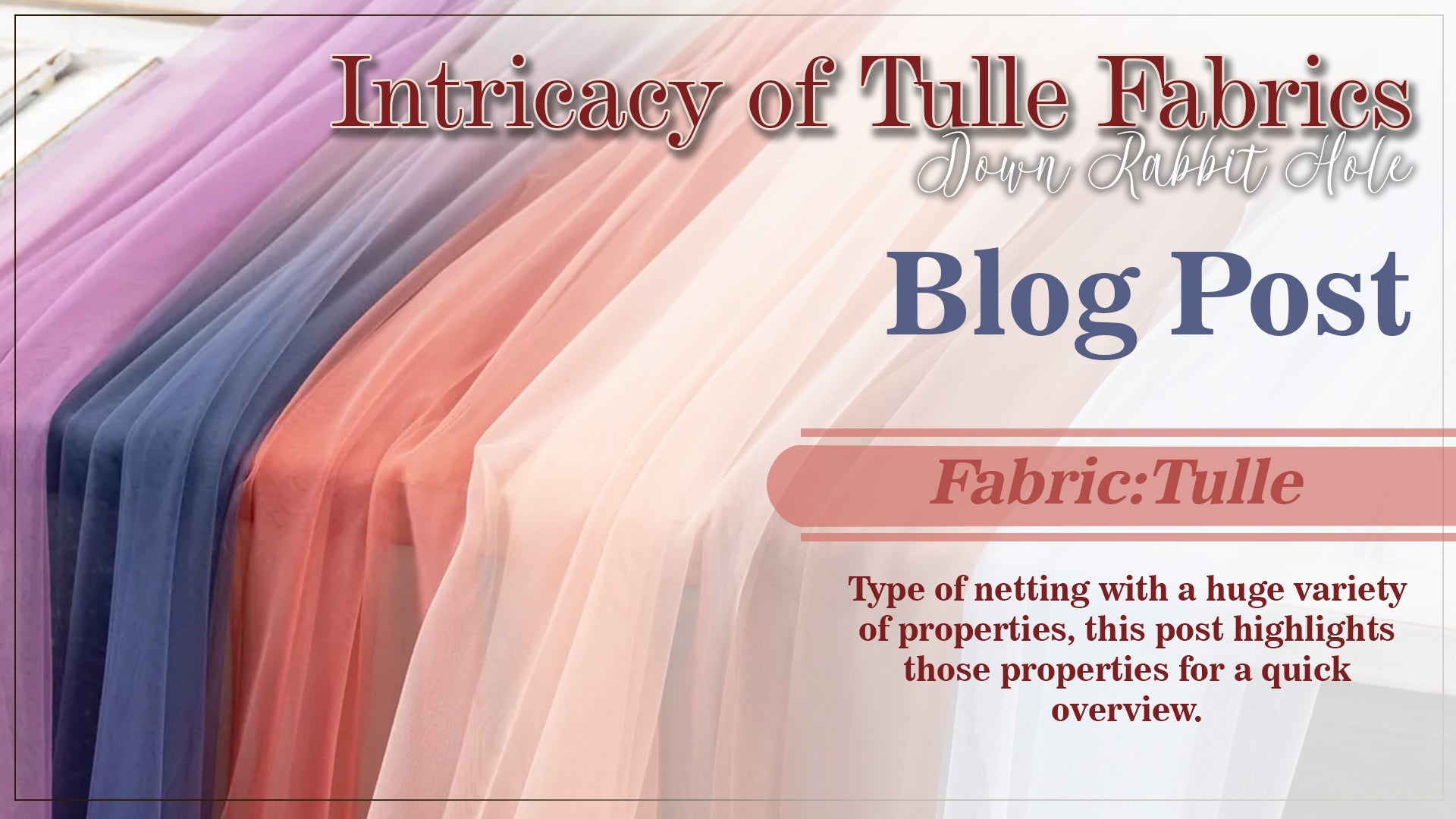Tulle Rabbit Hole
As the name suggests, I went down a rabbit hole when I discovered just how many types of tulle exist. What started as a bit of research quickly turned into an adventure through a world of textures, patterns, and possibilities. From the exotic elegance of beaded and polka dot tulle to the practicality of cotton and nylon tulle, the spectrum is as vast as it is fascinating. Each type has its own unique qualities, uses, and quirks, and in this article, we’ll dive into the highlights of each one to give you a clearer understanding of their pros and cons.
1. Silk Tulle
- Heat Resistance: Silk tulle is sensitive to high temperatures; it can scorch or lose its shape if exposed to heat sources like irons or dryers.
- Durability: While silk tulle is luxurious and soft, it is less durable than synthetic options. It can wear out faster due to friction and environmental factors, making it more suitable for special occasions rather than everyday use.
- Made from 100% silk, known for its softness and delicate appearance.
- Commonly used in high-end fashion and bridal wear.
2. Nylon Tulle
- Heat Resistance: Nylon tulle can withstand moderate heat but should be treated carefully; excessive heat can cause melting or deformation.
- Durability: Known for its strength and flexibility, nylon tulle is quite durable and holds its shape well. It is resistant to wear and tear, making it ideal for costumes and decorations
- The most common type, known for its durability and affordability.
- Ideal for tutus, masks, and decorative items.
3. Polyester Tulle
- Heat Resistance: Polyester tulle has better heat resistance compared to nylon; however, it should still be kept away from high temperatures to avoid damage.
- Durability: This type of tulle is highly durable, wrinkle-resistant, and retains its color well over time. It is commonly used in crafting and event décor due to its sturdiness
- Wrinkle-resistant and easy to clean, often used in crafts.
- Available in various colors and commonly referred to as "net fabric."
4. Cotton Tulle
- Heat Resistance: Cotton tulle can handle moderate heat but may shrink if washed in hot water or dried at high temperatures.
- Durability: While softer and more breathable than synthetic options, cotton tulle is less durable than nylon or polyester. It can fray or tear more easily, making it less suitable for heavy-duty applications
- Made from cotton fibers, offering a flexible and soft texture.
- Less common but suitable for everyday applications.
5. Illusion Tulle
- Heat Resistance: Similar to nylon tulle, illusion tulle should be kept away from direct heat sources to prevent melting or damage.
- Durability: Illusion tulle is generally durable and holds its shape well, making it a popular choice for bridal wear and formal garments
- Lightweight and sheer, often used in wedding dresses.
- Typically made from nylon or polyester, creating a "second skin" effect.
6. English Silk Tulle
- Heat Resistance: English silk tulle is delicate; exposure to high heat can damage its fibers.
- Durability: While it offers a luxurious appearance, it is not as durable as synthetic alternatives and requires careful handling
- A heavier variant of silk tulle with a textured feel.
- Often used for creating full skirts and elegant gowns.
7. French Silk Tulle
- Heat Resistance: Like other silk tulles, French silk tulle is sensitive to heat and should be treated with care.
- Durability: This type of tulle is exquisite but delicate; it may not withstand heavy usage over time compared to synthetic fabrics
- Lightweight and delicate, perfect for layering without added weight.
- Highly favored for bridal veils due to its luxurious appearance.
8. Italian Tulle
- Heat Resistance: Italian tulle has moderate heat resistance but should still be handled carefully to avoid damage.
- Durability: Known for its high quality, Italian tulle offers good durability but may not match the resilience of nylon or polyester options
- Known for its high quality, made from silk or nylon.
- Offers a soft texture and is popular in couture fashion.
9. Glitter Tulle
- Heat Resistance: Glitter tulle can be sensitive to heat; the glitter may melt or degrade if exposed to high temperatures.
- Durability: While it adds sparkle to designs, glitter tulle may be less durable due to the added embellishments that can wear off over time
- Features sparkling elements, ideal for adding glamour to designs.
- Popular in fashion and wedding industries.
10. Stretch Tulle
- Heat Resistance: Stretch tulle can handle moderate heat but should be protected from high temperatures that could cause deformation.
- Durability: This type of tulle offers good durability due to its elastic properties, making it suitable for fitted garments
- Treated with elastic threads to allow stretchability.
- Provides a comfortable fit, making it suitable for various garments.
11. Ombre Tulle
- Heat Resistance: Ombre tulle's dyeing process might make it sensitive to heat; care should be taken when ironing or washing.
- Durability: Generally durable like other synthetic tulles, ombre tulle maintains its appearance well with proper care
- Displays a gradient color effect, transitioning from one shade to another.
- Adds an ethereal look to outfits, popular in special occasions.
12. Beaded Tulle
- Heat Resistance: Beaded embellishments may not withstand high temperatures; care should be taken during cleaning.
- Durability: The beads add weight and complexity; while the underlying fabric may be durable, the beads can fall off with heavy use
- Embellished with beads or sequins for added sparkle.
- Perfect for eye-catching dresses and formal wear.
13. Polka Dot Tulle
- Heat Resistance: Polka dot patterns are usually printed onto the fabric; excessive heat could affect the print.
- Durability: Similar in durability to standard nylon or polyester tulles, polka dot tulle holds up well under typical conditions
- Features small dots made from various materials on the tulle base.
- Adds a playful touch to garments like skirts and tutus.
14. Micro Tulle
- Heat Resistance: Micro tulle has good resistance to moderate heat but should still be handled carefully.
- Durability: It is relatively strong for its lightweight nature, making it suitable for various applications including fashion and crafts
- Characterized by small mesh patterns; typically made from synthetic fibers.
- Used in fashion as well as practical applications like mosquito nets.
Exploring the world of tulle has been an eye-opening journey into the versatility and charm of this fabric. Whether you're making a dreamy wedding dress, decorating for a special event, or adding a touch of whimsy to your projects, there’s a type of tulle perfectly suited for every project. I hope this guide has inspired you to experiment with new materials and broaden your creative horizons. Which type of tulle are you most excited to try? I know where we’ll be using it, hint’ big reveal in an upcoming project 😉










1 commentaire
Darlene Sewista
Thank you. Very helpful. I just wish I could find a store that sold all types of Tulle! Wouldn’t that be delightful, especially in every color.